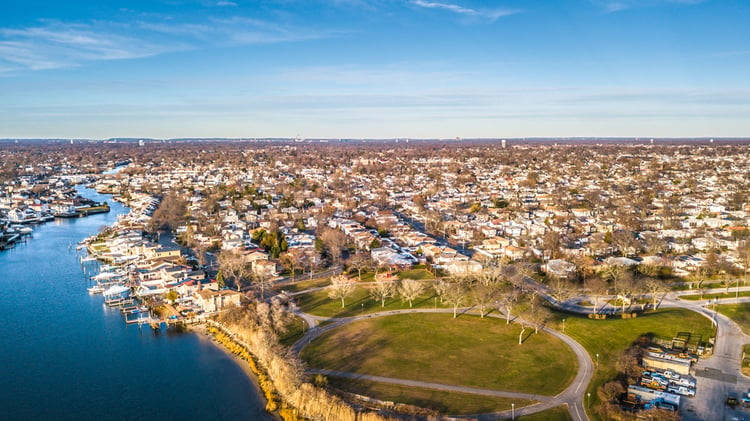Commercial solar photovoltaic systems generally have nominal capacities of several hundred kilowatts and many of them reach the megawatt scale. This represents an intermittent source of electricity, which reaches peak generation around noon. For this reason, utility companies establish interconnection requirements for distributed energy sources. These requirements are generally simplified for small solar installations, such as those used in homes, but larger commercial systems are subject to additional technical requirements.
In this article, we will provide an overview of the commercial solar PV interconnection requirements established by the 7 major utility companies operating in New York State:
- Central Hudson Gas and Electric
- Consolidated Edison
- national grid
- New York State Electric and Gas (NYSEG)
- Orange and Rockland Utilities
- PSEG Long Island
- Rochester Gas and Electricity
The NY Public Service Commission has created Standardized Interconnection Requirements (SIR) for solar energy systems connected to local grids, but specific requirements vary depending on your utility. If the capacity of your commercial PV system exceeds 50 kW, a Coordinated Electrical System Interconnection Review (CESIR) will also be required in most cases.
Get your commercial solar project approved quickly with professional photovoltaic system design.
The New York State Department of Public Service has a queue of all projects that are currently applying for interconnection under the SIR . The inventory is classified by concessionaires and provides information such as project location, zip code, substation and circuit.
Central Hudson Gas and Electrical Interconnection Requirements
If your commercial solar array is located in the Central Hudson Gas and Electric service territory, interconnection requirements will depend on the scale of the project. There is an interconnection procedure for projects up to 5 MW AC and another procedure for larger projects.
Solar projects up to 5 MW of capacity that will not participate in the NYISO wholesale energy market are subject to NYS Standardized Interconnection Requirements. If this is the case for your project, Central Hudson Gas & Electric has a link where you can submit the online application and request final interconnection approval. Central Hudson Gas & Electric has its own interconnection guidelines for solar projects larger than 5 MW.
These requirements apply to commercial solar projects that will connect to the Central Hudson Gas & Electric distribution grid, which participates in the retail energy market. On the other hand, if your project is to connect to transmission lines or substations and you intend to participate in the wholesale energy market, you must follow the application process established by the NYISO (New York Independent System Operator).
Con Edison Interconnect Requirements

Edison also follows the SIR for commercial solar projects smaller than 5 MW. They have a simplified application through an online portal if your project is smaller than 50 kW, and a flowchart that explains the application process for projects ranging from 50 kW to 5 MW.
Con Edison performs a preliminary screening of all solar photovoltaic applications, and you obtain the interconnection license directly if your project is approved at this stage. If your project is not approved immediately, there are three possibilities:
- Have a preliminary screening results meeting where you agree to the changes proposed by Con Edison.
- Have a supplemental screening analysis from Con Edison, delivered within 20 days.
- Have a complete CESIR from Con Edison, delivered in 60 days.
Supplemental screening analysis costs $2,500, and CESIR costs range from $1,450 to $8,000 depending on system capacity.
Con Edison provides a guide if your project is not covered by the Standardized Interconnection Requirements. Their guide covers three possible scenarios:
- Solar PV projects up to 10 MW with 460 V service
- Solar PV projects greater than 10 MW with high voltage service
- Off-grid projects
National Grid Interconnection Requirements
National Grid also classifies applications based on project scale. Solar projects below 50 kW will typically qualify for a simplified interconnection process without the need for CESIR. However, a study may be necessary in some cases, depending on local grid conditions, and also if your inverter system does not meet UL 1741. National Grid provides flowcharts for both application procedures:
- Solar photovoltaic projects smaller than 50 kW
- Solar photovoltaic projects greater than 50 kW
Commercial solar projects ranging from 50 kW to 20 MW must meet additional requirements, which include a CESIR study. National Grid uses SIR for projects up to 2 MW and its own technical requirements for larger projects (2-20 MW).
NYSEG Interconnect Requirements
Like most other utilities in the state, New York State Electric and Gas follows the SIR if your solar project is less than 5 MW, and they have an online portal where you can submit and track the application. NYSEG supports community solar projects up to 5 MW and provides specific information and requirements if your project falls into this category.
NYSEG also provides a list of circuits where the distributed generation queue currently exceeds system capacity. If you plan to connect a commercial solar panel to one of the circuits on this list, you will need to wait until NYSEG increases local grid capacity.
Orange & Rockland Utilities Interconnect Requirements
Orange and Rockland Utilities is a subsidiary of Con Edison and has very similar interconnection requirements for commercial solar projects. They classify solar PV projects into three categories, and there is a dedicated application portal for each category:
- Distributed generation projects up to 50 kW
- Distributed generation projects above 50 kW
- Community distributed generation
Orange & Rockland Utilities offers a list of documents that must be included in your application, mentioning specific requirements for projects above 50 kW or classified as community solar .
PSEG Long Island Interconnect Requirements

PSEG Long Island classifies distributed generation projects into two categories for interconnection purposes, providing a list of requirements and documents in each case:
- Distributed resource systems from 0 kW to 5 MW, which qualify for online application
- Distributed resource systems from 5 MW to 10 MW
The Smart Grid Interconnection Procedures for Small Generators (SGIP) provide additional details on the interconnection process depending on the size of the project. In general, projects below 50 kW qualify for accelerated interconnection approval. However, commercial solar panels and other inverter-based systems up to 300 kW may also qualify for the accelerated process if they meet the latest version of UL 1741.
Distributed generation projects between 50 kW and 5 MW require a CESIR study, conducted by PSEG Long Island, and may also include local grid upgrades. However, projects between 50 and 300 kW that qualify for accelerated approval are exempt from CESIR. Projects of 5 to 10 MW are also the subject of feasibility studies, to analyze their impact on the transmission system and determine the optimal interconnection voltage.
PSEG Long Island manages the interconnection procedure for solar energy projects up to 10 MW. If your project exceeds this capacity, you must connect to the high voltage transmission system and your request must be submitted directly to the NY Independent System Operator (NYISO).
Rochester Electrical and Gas Interconnection Requirements
Rochester Gas and Electricity has the same interconnection requirements as NYSEG, as both companies are owned by Avangrid. Commercial solar projects below 5 MW are subject to New York State Standard Interconnection Requirements, and application is submitted through an online portal. Like NYSEG, Rochester Gas & Electric provides a list of all circuits that are currently at full capacity, meaning they cannot support interconnection with more distributed generation projects until their capacity is upgraded.
Solar interconnection requirements: importance during the project design phase
Commercial solar is a proven investment: photovoltaic arrays have a useful life of more than 25 years when high-quality components are used, and the simple payback period can be less than five years under favorable conditions. However, the payback period can be reduced to zero if you qualify for grants and low-interest financing, and there are excellent incentive programs from NYSERDA if your project is located in NY State.
Utility interconnection requirements can present a technical challenge if the applicant is not familiar with them and can potentially delay your project. Getting your project drafted and approved quickly is critical when incentive programs are available:
- Solar incentives are often calculated per watt of capacity, and the incentive rate is gradually reduced as more projects are approved.
- The NYSERDA NY-Sun Megawatt Block Program utilizes this approach, gradually reducing financial benefits as capacity targets are met.
- There are also incentive programs with limited funding, and you may miss out if your solar PV project is not approved quickly.

